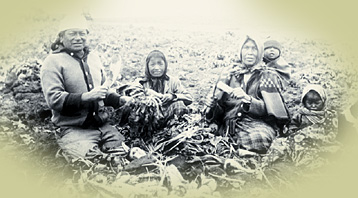|
|
Arrival of Strangers - The Last 500 YearsEconomyFarming"32. (1) A transaction of any kind whereby a band or a member thereof purports to sell, barter, exchange, give or otherwise dispose of cattle or other animals, grain or hay, whether wild or cultivated, or root crops or plants or their products from a reserve in Manitoba, Saskatchewan or Alberta, to a person other than a member of that band, is void unless the superintendent approves the transaction in writing. (2) The Minister may at any time by order exempt a band and the members thereof or any member thereof from the operation of this section, and may revoke any such order. (3) Every person who enters into a transaction that is void under subsection 32(1) is guilty of an offense." - Extract from the Indian Act Near the end of the 1800s, several developments changed the lives of the Cree, Assiniboine and other people of the Prairies. These included the decline of the buffalo, the establishment of treaties and reserves, and the building of the railway to open the land to immigrant farmers. Both Church and government encouraged Aboriginal people of the Prairies to become farmers. They achieved some success in the 1880s. But in 1889, the Peasant Farm Policy was implemented, effectively reducing what Aboriginal farmers' could earn. By the time the government abandoned this policy in 1897, it had seriously damaged Aboriginal farming. Aboriginal farmers never recovered. Today, Aboriginal people of the region continue to suffer poverty and unemployment. To provide jobs and income, some First Nations have opened casinos.
| |
